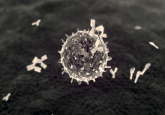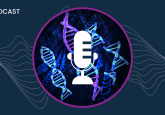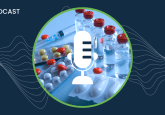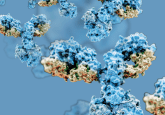The new frontier: qPCR vs ddPCR for cell and gene therapies
In the fifth episode of The new frontier podcast, we’re joined by Paul Byrne, Senior Director of Genomics from ProtaGene (MA, USA). Paul describes his experience working with qPCR vs digital and digital droplet PCR assays and advises on their pros and cons, as well as when it’s best to use each. We discuss how these assays can be optimized for cell and gene therapy targets and get a peek into the tips and tricks he’s picked up over his 30 years of experience.
Podcast transcript
[00:01] Ellen Williams: Hello and welcome to the fifth episode of the Bioanalysis Zone podcast on Cell and Gene therapies, sponsored by QPS Holdings. I’m your host, Ellen Williams, and today I’m joined by Paul Byrne, Senior Director for Genomics from ProtaGene. Thank you very much for joining me, Paul.
[00:24] Paul Byrne: It’s my pleasure. Thanks for having me. I’m looking forward to getting going.
[00:27] Ellen Williams: No problem. For those who are unfamiliar with your work, you’re an expert in analytical support for cell and gene therapies, particularly qPCR and ddPCR. Could you start off by explaining why these assays are useful for supporting cell and gene therapy work?
[00:44] Paul Byrne: Yes, certainly can. Good question. Again, thanks for having me on this podcast. It was interesting to hear you refer to me as an expert. I don’t really look at myself in that way. Although I do acknowledge I’ve been doing it for a very long time, so maybe I’m just being a bit too modest. Yes, I think these molecular biology tools are very, very important during the development of cell and gene therapy. So whether it’s a qPCR, a digital or a digital droplet PCR, [they are] very powerful and important tools used during the entire development of cell and gene therapy molecules from discovery straight through to commercialization.
Whether it’s preclinical bio-distribution for a gene therapy or the corresponding clinical development, [like] looking at shedding, if we’re maybe working with adoptive cell therapies, so we’re doing vector copy number, cellular kinetics, [we are] looking for advantageous agents that we can use these molecular tools. I think even though it’s slightly off-topic for today’s podcast, they’re also very important during the CMC portion of development, so basically the support of the manufacturer of these products. So these molecular biology tools are very important for looking for impurities or involved in the very critical parameter, which is the titering activities. So, hopefully, that gives you a bit of a snapshot, a bit of an idea of how important and critical these molecular biology tools are to be used during the development of cell and gene therapy molecules.
[02:10] Ellen Williams: Thank you, yes. That was a super useful summary of those types of techniques. Thank you for that. I guess my second question then is, can you describe your experience within designing and optimizing these assays specifically for cell and gene therapy targets?
[02:26] Paul Byrne: So, yes, I’ve been designing these types of assays for many years, and personally, I think that the design is albeit maybe one of the most critical steps, [and is] also the most straightforward. The reason I say that is we have software that designs the assays for us and we’ve got other pieces of software that [do] theoretical assessments to make sure we don’t see any issues when it comes to actually practical testing and a background of relevant species of DNA.
I think maybe one of the more challenging aspects is inputting the relevant portion of DNA into the software. What we’re really trying to do here is really target these modifications to these molecules. Sometimes we need to really kind of force the software to design primers and probes that will span that junction of modification and that hopefully give us an assay that is specific to our target with little or no cross-reactivity with relevant species of DNA. I think, to summarize, your assay design these days is relatively straightforward, but it can be a challenge in trying to get the software to design primers and probes to the specific regions that you’re looking at.
So the design for qPCR and digital PCR and digital droplet PCR assays is very similar. At the end of the day, they use the same chemistry, but the optimization of the assays can be quite different. While a qPCR can be optimized over several runs, the same is unfortunately not the case with the digital and digital droplet PCR assays. They usually require much more development and optimization as we work towards having acceptable levels of accuracy and precision, especially at the lower limits of the assay. So just a quick example there of how the optimization can be quite different between qPCRs and digital PCR assays.
[04:13] Ellen Williams: So what are some of your tips and tricks that you’ve learned from your years of working with these assays?
[04:19] Paul Byrne: Yes, I’m pretty old school. I’ve been doing it for a long time. I think my main tip is really not to overcomplicate what you’re doing and not to spend too much time trying to troubleshoot and understand why you’re generating slightly unusual results. Sometimes it’s just best to go back to the drawing board and redesign some new primes and probes or even just discard your reagents and start again. That sometimes actually works quite well. We recently had an assay that just stopped working overnight, and as we were investigating, we swapped out one of the primers. This primer that we swapped out was being used for another assay that was working. But as soon as we swapped out that primer, this assay started working and has worked ever since. I think the take-home message is that sometimes there’s no rhyme or reason for why these assays stop working and then start. It might take you months and months to figure that out. So don’t spend too much time, don’t overcomplicate it, and don’t be scared to go back to the drawing board. I think that’s my main tip.
[05:15] Ellen Williams: That sounds like really solid advice. Thank you for that. Maybe you could comment on some of the common challenges or sources of variability that you’ve encountered in qPCR and dPCR-based bioanalysis of cell and gene therapies. How do you normally address them?
[05:33] Paul Byrne: Yes. We could probably be here all day answering this question, but just to briefly touch on a few things. I think, first, we’re very lucky with these types of methods compared to other bioanalytical methods [in] that a well-designed assay should have minimal challenges and/or little variability. But it is something we focus on during development and validation, so we look at changing operators, equipment [and] reagents, just to make sure that those changes don’t have an impact on the variability. But saying that, we still have some challenges and we do sometimes see some issues with variability.
I think the main challenge that I focus on because we’re using such sensitive techniques, is contamination. So that’s either cross-contamination between samples or something that we’re introducing from an environmental source. We spend a lot of time focusing on very well-defined workflows. We have separate labs and air spaces for different steps of the procedure, but we also have the appropriate controls as well, so that if we do see contamination, we can pinpoint it and take control of it. How we address that is usually a deep clean and/or discarding relevant reagents and then starting again, but yes contamination is one of the big challenges for running these types of studies.
[06:43] Ellen Williams: Great. Thank you, Paul. What does some of the current BMV guidance say about these assays and what do you think may be missing from this guidance?
[06:51] Paul Byrne: That’s a really good question. I’m actually starting to hear more people mention the BMV with regard to molecular assays, which is surprising as I thought we had moved on from that. For anyone who doesn’t know, the BMV is an FDA guidance document. It’s called the Bioanalytical Method Validation. The reason I’m surprised is that I don’t think the BMV has any relevance to what we’re doing. It’s written in a way where it focuses on specific guidance for ligand binding and chromatography-type assays.
So even if it does touch on a validation parameter that is relevant to what we are doing with molecular assays, the way that parameter is assessed and the acceptance criteria for data, is just not really relevant in the slightest. I think the only guidance from the BMV that I think has been universally incorporated into these molecular biology-type assays is the use of QCs, so a DNA spike with a known concentration of your target, and that’s used to monitor for assay performance. But other than that, it has very little relevance.
Now you ask what is missing from the guidance. For me, as I probably just touched on there, what is missing is any reference or relevance to the molecular assays. I think we’re actually at a point where I don’t think we need to have a very strict and formal regulatory guidance for these types of assays. We have lots of really great White Papers that provide excellent and specific guidance. We’ve got the MIQE. There are groups in Europe and America that have qPCR working groups, like the EBF and the AAPS. So, I don’t think the BMV is relevant. I don’t think we need a regulatory document.
Yes, I do acknowledge that some of the parameters are open to interpretation. I think, in my experience, everyone does it slightly differently, so it could be different numbers of plates, replicates could be different, the acceptance criteria could be slightly different. But I think the end result is always the same. You have an assay that is fit for purpose for its intended use, whether that’s preclinical, CMC or clinical. I think that’s really the focus here. It’s just to understand what your method’s going to be used for and building up your validation accordingly.
[08:53] Ellen Williams: You did mention there, you know, you go to EBF, AAPS, and these are really very collaborative events, where there is a lot of exchange of information and it really is a good place to stay up-to-date on what other people are doing. Do you have any other ways that you keep up with the latest advancements and best practices within this technology and their applications in cell and gene therapy research?
[09:24] Paul Byrne: Yes, you really touched on it there. Going to conferences, being involved with these qPCR working groups or just reading the White Papers is a great way of staying up-to-date with the latest advancements. I think, for me personally, it really comes from talking to clients, to people who we are supporting in terms of developing their drug. I think there’s a specific reason for that, and I think it’s because we always seem to get good feedback from these clients because they’ve got a direct line into the regulators. That’s gold dust, certainly for me, getting that feedback in terms of what the regulators are expecting with regards to development, validations or actual sample analysis. So, yes, there are a lot of ways to keep up-to-date but for me, I always seem to learn most from the clients that I’m engaging with.
[10:09] Ellen Williams: Yes, that definitely makes sense. Those conversations are so important. Another quick question then. When would you say it’s best to use a qPCR assay versus a digital PCR assay during preclinical and clinical development of cell and gene therapies?
[10:24] Paul Byrne: So this is the million-dollar question, and I think quite a hot topic at the moment. Again, I’m old school. I’ve been doing qPCR for probably almost 30 years now. I think in the right hands, a well-designed and validated qPCR assay can be used to support all forms of preclinical and clinical applications. But what we’re seeing is more and more companies are asking for digital or digital droplet PCR assays. They’re also using these platforms internally to develop these methods and want to transfer them to support both preclinical and clinical studies, so the digital and digital droplet PCRs are definitely here to stay.
In terms of what’s best to use, I think it’s very important to understand what the pros and the cons are for each platform before choosing how to move forward instead of just choosing digital PCR as it’s the new kid on the block without really understanding it. And actually, we do see that quite a lot. Companies have implemented digital or digital droplet PCR to support preclinical and clinical development just because it’s the new shiny box in the lab without actually knowing what its pros and cons are.
Again, there are many more than this, but just to maybe touch on some of the more pertinent pros and cons that are relevant to what we’re talking about today: so, digital and digital droplet PCR assays have a very small dynamic range, especially when compared to a qPCR. So if you’re supporting a preclinical or a clinical study where you’ve got samples that are either highly concentrated or there are a variety of concentrations, then it can be quite tricky putting in place a dilution scheme to dilute all of those samples down into the range of your digital or digital droplet PCR assay.
If you miss that range, you’re going to have to re-dilute it and repeat, and that takes time and that will cost money. For some studies we’ve supported, you’re looking at a 50% repeat rate for samples that are falling outside of that very small dynamic range. That’s something very important that needs to be factored in when you are developing your preclinical or clinical strategies. The other thing is that some of these methods can be quite time-consuming, especially the digital droplet PCR workflows. It’s a lot more hands-on and longer to run the samples, and that equates to extra time. That means it’s going to cost you more money to run each assay, certainly when compared to a qPCR or a digital PCR, which actually has a similar workflow to qPCR. But that in combination with the previous point about the small dynamic range, it can actually make your programs quite expensive and take a lot longer to test because you’re doing so many repeats.
Looking at the alternatives, for qPCRs, again, I’m a big advocate of qPCRs, because I’ve been doing them for a long time. But if you want to multiplex, so if you want to look for more than one target at a time, that can be tricky on a qPCR as you need two standards, they need to be amplifying in the same efficiencies so you can compare them against each other. With digital [and] digital droplet PCR, you don’t have a standard. It’s an endpoint assay, you have less PCR bias, so it is easier to do multiplexing on the digital platforms. So, again, understanding the pros and the cons, what it is you’re trying to achieve and taking it from there.
I think moving forward, I’d like to think we’ll still see a nice split of qPCR and digital PCRs, including some sensible decision-making, but we’ll see how it develops. I think from recent experience [when] we’ve supported preclinical studies, maybe one in three preclinical studies are now using digital or digital droplet PCR [whereas] in the clinical space, that ratio is much higher. We’ll see how that develops over the next couple of years.
[13:53] Ellen Williams: My final question that I really enjoy asking people is, can you share something that you or your team are doing in your lab that you’re really excited about?
[14:04] Paul Byrne: I think what is exciting is, historically, it was just qPCR. Every 7 or 8 years, we’d get a new platform. It’d be a new box, but the chemistry would be the same. The theory was the same, but the software may be a little bit different. Whereas now, it’s not just qPCR, you know, it’s digital PCR, it’s digital droplet PCR. I think what’s really exciting for myself and the people in the lab is just getting hands-on time with different instruments, learning how to use them, and learning how to support a variety of molecules, and that takes me on to my next point.
I think, historically, for me, it was always AAV, almost all AAV with the odd cell therapy, whereas now it’s much more diverse. We still see a lot of AAV-based gene therapies, but we’re also supporting the development of adoptive cell therapies, both in vivo and ex vivo-modified. We’re seeing small oligos, siRNAs [and] gene editing. The list goes on. I think this is really exciting for us not only to have hands-on time with a [greater] variety of equipment but just to support a real diverse selection or collection of molecules and just learning how to use them. You know, qPCRs and digital PCRs are relatively straightforward, but every molecule seems to have a slightly different approach, a slightly different challenge. It keeps us on our toes. But yes, that’s what’s really keeping me excited at the moment.
[15:26] Ellen Williams: Great. Thank you so much for sharing your experience, Paul. It has been really lovely to speak to you.
[15:31] Paul Byrne: Thanks for your time and just thanks everyone for listening. I hope something was relevant in there. Yes, thank you.
About the speaker:
 Paul Byrne
Paul Byrne
Senior Director, Genomics
ProtaGene
Paul is a Senior Director of Genomics at Protagene and has 30 years of experience in the industry. He can frequently be found speaking at symposia on topics including analytical development challenges for advanced therapy medicinal products (ATMPs), biodistribution and safety assessment considerations for cell and gene therapies. Paul received his BSc (Hons) in Biology from the University of Stirling and his MSc in Research from the University of Glasgow (both UK).
![]() Listen to other episodes in this series here.
Listen to other episodes in this series here.








